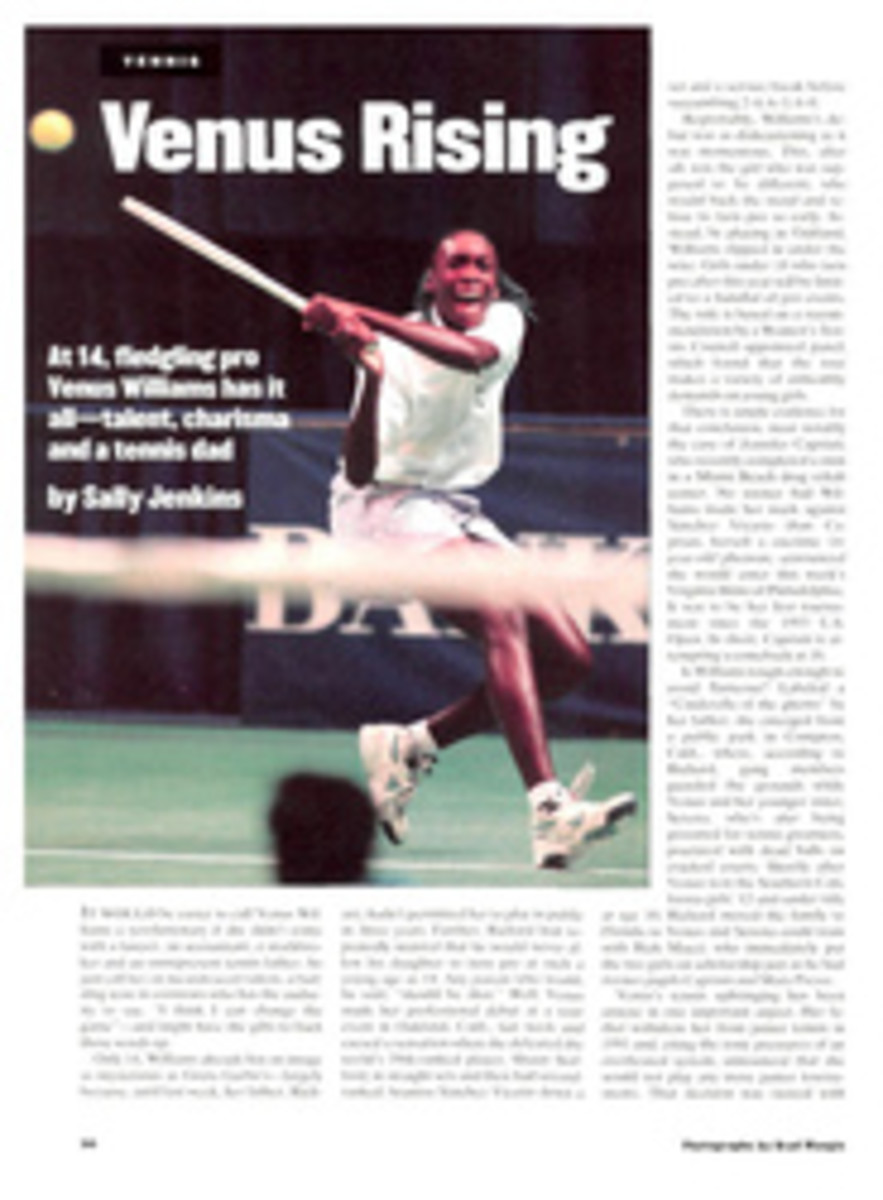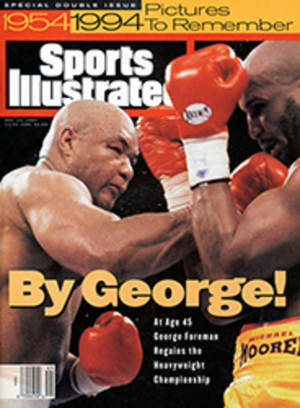
A Three-Day Wonder
Bruce Davidson's feet are never on the ground for more than five minutes. He mounts one horse, warms up, performs in the ring, dismounts, mounts another horse, warms up, performs, dismounts, mounts another horse—it goes on all day long. His face is impassive, his voice is soft, and his concentration is trained solely on the animal he is riding. By the end of the day, however, he shows signs of being tired. "Mr. Davidson, your number this time?" the jumping judge inquires as Davidson rides into the arena yet again. "Madam, I don't know," he says, and the crowd cracks up.
Davidson is participating in the Middletown Pony Club Horse Trial, a small two-day show held in Middletown, Del., at the end of September. During the show riders test their horses' abilities in three phases: dressage, which measures suppleness and obedience; stadium jumping, which calls for strength; and cross-country jumping, which tests gymnastic ability and endurance. During this first day of the event Davidson, a tall, angular man with pale-blue eyes, a shock of white hair and a perfect farmer's tan, has ridden six horses in the dressage and stadium jumping events.
Horse trials are training grounds for the more rigorous three-day equestrian events, which include "roads and tracks" (several miles of trotting or cantering) and the endurance phases of a steeplechase. Davidson, who only a week earlier won first place at England's Blenheim International Three-Day Event, is in Middletown to help his younger horses practice. "We're not here to compete," he says. "We're here to learn."
Davidson, 44, has reigned over three-day eventing for 20 years. Raised in rural upstate New York, he was a Pony Club member as a child. He learned about eventing at the McDonogh School, a private high school outside of Baltimore, and began his competitive career in 1970 when he joined the U.S. equestrian team (USET). At the 1972 Olympics in Munich he contributed to a team silver medal. He went on to a series of major international victories, including individual and team gold medals at the 1974 world championships, the team gold at the '76 Olympics, individual gold and team bronze medals at the '78 world championships, the team gold medal at the '84 Olympics, an individual bronze medal at the '90 world championships and first prize at the '93 USET Three-Day Championships—not to mention hundreds of trial wins in this country and abroad.
Davidson spends much of his time on the road at competitions: This year he spent six months competing in Europe. His home base, however, is Chesterland, a 250-acre farm in Unionville, Pa. There he and his wife, Carol—a former top rider who now serves as a horse trainer and, she says, "cheerleader" for her family—live with their two children, Buck, 18, and Nancy, 16, as well as 70 horses and numerous chickens, ducks, geese, parrots, golden pheasants and lurchers. These last are dogs (half whippet or greyhound, half anything else) that spend their days racing around the farm.
The keys to Davidson's success are both obvious and intangible. There are, of course, his horses, which are bred from champion thoroughbreds to have the strength, endurance and grace required of mounts in international events. Davidson is "an extraordinary judge of a horse's capabilities," says James Wofford, a silver medalist who rode with the USET during the 1960s and '70s.
Then there is the land. Chesterland used to host three-star international events (four-star events are the most difficult), so Davidson has his own demanding cross-country course on which to condition his horses. And on the property surrounding Chesterland, Carol Davidson's mother, Nancy Hannum, runs one of the oldest and largest fox hunts in Pennsylvania, providing more excellent training ground for her son-in-law's horses.
Finally there is Bruce Davidson's ability to figure out what a horse is telling him. He calls it listening to the animal. "He's very intuitive," says Tom Lurito, a horse veterinarian and one of many students who have trained privately with Davidson over the years. "He gets rid of the frivolity between horse and rider and focuses on the horse. People bring him these orangutan horses and say, 'I can't make him round, I can't get him over this jump,' and he gets on and does it."
To humans Davidson is something of an enigma. With strangers he can be aloof. With family, friends and other riders he can be kind, inquisitive, even whimsical. At Chesterland he sees three lurchers racing by and asks, "Wouldn't it be cool to ride one?" He can be an exacting taskmaster. Former students speak of being told to do things over and over. And almost everyone has a story about Davidson's scathing sarcasm or about the tantrums he has thrown—before grooms, judges, other competitors, his wife, his students, even his horses. "He can be a holy terror," says one woman at the Middletown show.
Those who know Davidson well say they become used to his intensity. "People are surprised that I know how to work with horses as well as I do," says Carolyn Weinberg, once a student of Davidson's and now a veterinarian in Connecticut. "But I know how to wrap legs because Bruce made me do it six times in a row, until I got it exactly right. There's nothing wrong with the meticulousness he demands. You won't learn it elsewhere."
It is afternoon in Middletown. Bruce and Buck Davidson are walking the cross-country course. The two-mile route will be ridden at a hard gallop, broken only by the highly technical maneuvering it takes to get horse and rider over jumps that include combinations of water, fences, ditches, hills, hedges and logs. Each obstacle demands planning and pacing, and during this walk, as on most of Bruce's course walks, a gaggle of riders follows to listen.
Davidson approaches the seventh jump—a log three feet high, a drop into a dirt road, a bound up a bank, and another three-foot log—with his head cocked slightly to one side. "This is beautiful," he says. "This is excellent. Just don't hang on their faces. Let them jump." He asks a young girl beside him how she'll handle the obstacle, and as she points to her imagined path, he nods. "Remember not to gallop here," he says kindly. "If you come too fast, she won't see the road, and she'll get scared."
Forty-four is not old for a rider—some eventers compete into their 50's—but it is getting there. Davidson is not thinking about retirement but says that when the time comes, he will remain involved in racing, fox hunting and horse breeding. And he says that as he slows down, one of his greatest pleasures is seeing his children become interested in the sport. "This is a great inspiration for me," he says. "It was always a dream that they would ride with me."
Nancy helped her father during his European tour last summer. Buck trained with the Young Rider's Association team (for riders under 21) and beat his father at last year's Radnor International Three-Day Event in Pennsylvania. "I can't have a lazy day around him," says Buck. "But I've got the best coach in the world. Now I'm waiting for the day when they say, 'There goes Buck Davidson's father' and not 'There goes Bruce Davidson's son.' "
Bruce's own enthusiasm may be critical to the future of his sport, in which costs are high and monetary rewards are low. First-prize purses at England's Badminton and Burghley four-star international events are $30,000 and $15,000, respectively. First prize at Fair Hill, one of only two three-star international three-day events in this country, carries no money at all. Sponsorships are scarce—Davidson has modest support from Purina and receives tack from Miller's Harness—and media coverage, especially in the U.S., is rare. Yet the animals themselves are worth upward of $100,000, and round-trip air travel to European events costs $10,000 per head.
Rewards for spectators, on the other hand, are great. "In cross-country, spectators stand right at the jump," Davidson says. "It's incredibly dramatic—like standing at the three-yard line in football." Crowds, however, are still not big. "If they tripled the prize money," Davidson says, "the public would come."
But the sport's lack of publicity in no way diminishes Davidson's stature among riders and fans. At Middletown a girl approaches a stranger at ringside and asks, hopefully, "Do you know Bruce Davidson? I need his autograph." When asked what she likes about Davidson, she says, "He wins a lot, and he has a good seat." She watches Davidson canter by. "I love him, and I love his horses."
PHOTO
BILL EPPRIDGE
Davidson's gift for communicating with horses helps get them over and through all sorts of obstacles.
PHOTO
JAMES DRAKE
Olympian Davidson (second from left) won a team gold in 1976 but couldn't leap to a medal in '88.
PHOTO
RICHARD MACKSON
[See caption above.]
Susan Davis has written several stories on equestrian topics for Sports Illustrated.

